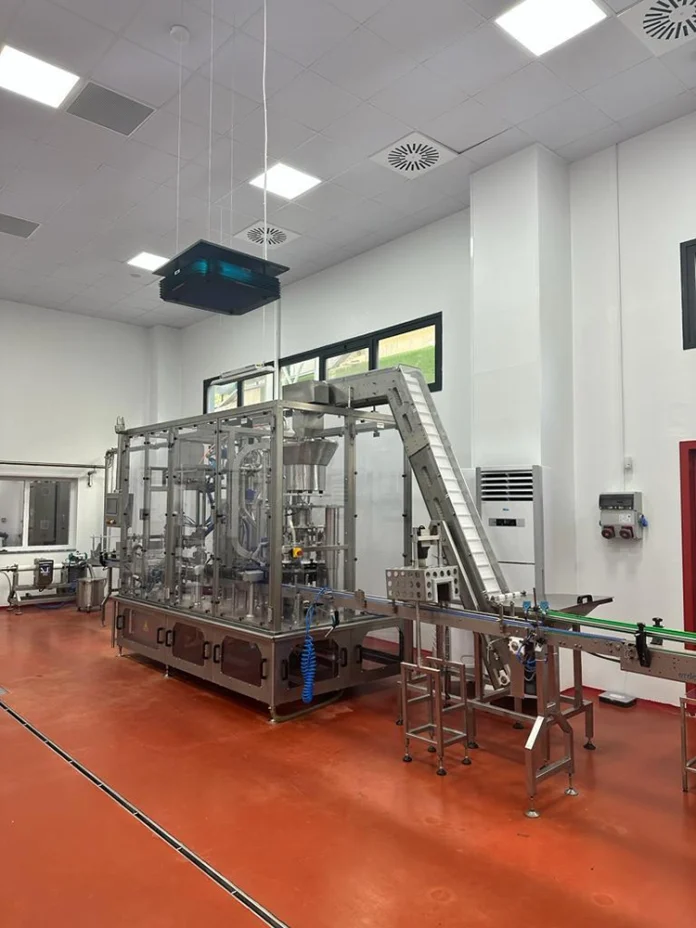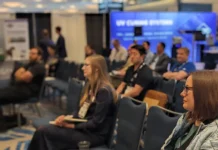Danny Bayliss, New Technology Lead, Campden BRI, [email protected]
Neil Avner Cikurel, director, RND Arastirma Gelistirme Tasarim, [email protected]
IUVA Food and Beverage Safety Working Group
Ultraviolet light is known for its antimicrobial effects. The band C part of the spectrum is the frequency range 280 to 200 nm and has strong DNA absorption peaks. The modification of the DNA by low-pressure mercury lamps emitting 254 nm has unlocked decontamination and disinfection applications for the technology.
Equipment manufactured for use in a food-production environment needs to consider what will be happening in these types of environments to ensure the equipment can be installed and safely maintained. If the technology also is being used to treat food products, then there are considerations about not only the safety of the machine but also the potential safety of the product. This column will review some of those considerations.
Operation, environment and pressure
Food production places pressure on manufacturers to meet targets for their customers to avoid financial penalties, especially if deliveries are late. Under stressful situations, a decision can be made to switch off machinery due to over-rejection or to speed up a line to get more throughput and make up for lost time. Speeding up a UVC line that is treating food products may reduce the efficacy of the process due to underdosing, which may have food safety implications. Access to the system controls needs to managed by facility personnel who understand the risks and have been involved in validating the technology.
The light itself is harmful if exposed to human skin and eyes, and there are legal accidental exposure limits for UVC light, so interlocks must come as standard on these types of machines to avoid any accidental exposure. Pressure to keep a line moving and limited understanding of the dangers require the right guarding and shielding to limit someone looking down the line to see what has gone wrong or putting an arm in to try to fix something – or even thinking about getting a suntan! Stories about the happenings on nights shifts sometimes can sound unbelievable but sadly are true, so ensure controls are in place to guard against this.
Lamp maintenance also needs consideration. Lamps are made of glass, leading to a risk of breaking and releasing very small concentrations of mercury. Operators need to be trained in the correct procedures in the event of a glass breakage. Manufacturers will want assurance that no glass can enter the product on the line as a foreign body, and many factories have no-glass policies (unless it is a packaging component). A great way to prevent or limit possible glass contamination is to cover the lamps with a fluorinated polymer (FP) material, which still allows >70% of the UVC light through but can contain the glass in the unfortunate event of a breakage.
Cleaning is an important consideration in a food production environment from three perspectives.
Lamp Output: The first consideration is the output of the lamp and any FP covers used, as some production processes may dirty the surfaces over time – compromising light output and potentially safety, depending on the application. The frequency of cleaning for lamps and protectors should be established with the manufacturer based on the production environment and potential soiling. The same cleaning standards also may be applied directly to the lamps, depending on the final equipment application.
Machine Design and Construction: The second consideration is the machine design itself and its construction. The latest BRCGS 9.0, section 4.2.6, states: “The design and construction of equipment shall be based on risk to prevent product contamination. For example, the use of the correct seals, impervious surfaces or smooth welds and joints, where they are exposed to product and could otherwise result in foreign-body, microbiological or allergen contamination of the product. Equipment that is in direct contact with food shall be suitable for food contact and meet legal requirements where applicable.” The new regulations many manufacturing sites will be working with require machinery used to be of a hygiene standard in line with the best practise. This means manufacturers should be considering the latest recommended guidance and principals in their design, from European Hygienic Equipment Design Group (EHEDG) and or the US 3A. It is important that a machine easily is cleaned, with no trapping points for microbes to establish, grow and potentially cross-contaminate food products.
Cleaning Procedures: The third factor to consider is the cleaning procedures of the equipment. In many food factories, water and chemicals for cleaning and sanitation frequently are used. Cleaning teams spray down much of their machinery and will want to do the same to the UVC system. Ensuring the correct IP rating of the electric cabinet, while also maintaining the right electronic temperature, is important. Instructions should be included during training on how to handle lamps during the cleaning process so the lamps are not damaged from water ingress.
Food processing
Early use of UVC technology means its application is not considered by novel foods in the EU unless the product has not been widely consumed or the process gives rise to substantial changes from a microbial, toxicological or nutritional standpoint. Some member states, however, have restrictions on where the technology can be applied, which must be considered if looking to expand into different markets.
Substantial changes in a product can be nutrient-positive changes, such are treating yeast with UVC to boost vitamin D2. Extending the life of milk also increased vitamin D3 and therefore was subject to the novel-foods approval process. Before applying the technology to food products, consideration should be given to the impacts the process may have on the product composition and whether these may have safety considerations – or, just as important, quality modifications – which will result in consumers not liking or accepting the product. UVC light can interact with unsaturated bonding structures where the electrons are delocalized. This can give rise to taints in the product if they are high in unsaturated fats and exposed to a high enough dosage. There is a balance to be struck with the target dose delivering the microbial control but not negatively impacting the product quality.
Food and drink manufacturers should perform their own validation and due diligence on the application of UVC technology to ensure the technology performs as they expect and that the correct parameters are in place to monitor and verify the process. Many food and drink manufacturers will expect the equipment provider to have the data. With such a vast array of products treated and many results confidential to clients, there is very little data manufacturers can draw from for the specific food, target audience and dosages used. To add to this, the food product and target organisms heavily will influence the log reductions achievable. There is a point of diminishing returns for the applied dose compared with the log reductions achievable, so a balance has to be struck in many applications so quality is not compromised.
The Industry/EU/Turkey Perspective
By Neil Avner Cikurel, RND Arastirma Gelistirme Tasarim
UVC technology mainly is used in the food production environment for surface disinfection (surfaces in contact with meat/poultry/fish/dairy products, cold storages, etc.); air disinfection; food processing; and food packaging disinfection.
During the pandemic, due to health hazards caused by surface disinfection and air purification equipment with false/understudied claims, Turkey became one of the first countries to regulate these equipment types (see article in Issue 4, 2021, UV Solutions). Ministry of Health categorized all products using UVC to disinfect surfaces and/or air as biocidal products with no active ingredients and strictly regulated them. Any product aiming to enter the market should pass mandatory tests: microbial efficacy (min. 4 log reduction for bacteria and viruses, 3 log for fungus), cumulative ozone production, UVC leakage and UVC wavelength. Recently added was the UVC exposure test for upper-room UVGI systems, according to the directive 2006/25/EC. Equipment also should meet the CE standards. Although UVC surface and air disinfection equipment strictly are regulated in Turkey, there are no such regulations for the equipment in food processing and direct exposure of food ingredients or food.
Prof. Dr. Sevcan Unluturk, who actively works with UVC technology in her research projects and is a faculty member of the food engineering department of Izmir Institute of Technology, was consulted to get her insights and the latest information on the regulations. Since Turkey is one of the most important food exporters in the world, all regulations are aligned with standards from the United States (USDA, FDA) and/or European standards. However, there is no standard or regulation directly addressing non-thermal processing technologies, including equipment using UV technology. In addition, FDA regulations do not mention any minimum or maximum dose of UVC to be applied during food processing. Instead, it is stated that these criteria should be reliably determined situationally by good manufacturing practices.
The lack of regulation puts the burden on the manufacturers of equipment for food processing. A reputable designer and manufacturer of UVC equipment for food processing and food safety will have a bilateral approach to safety: 1) Safe use of UVC technology and methodology for how users can be sure they are reaching the desired levels of reduction on food ingredients, on surfaces or in the air; and 2) safety of the people who are operating/servicing such equipment.
Providing a uniform UVC dose is at the core of a successful UVC irradiation process and the reproducibility of the results at the commercial scale (Pendyala et al. 2021 ¹). However, determining the performance of the UVC irradiation and its germicidal effect is quite complex, as it depends not only on microorganism susceptibility, but also on the properties of the food being processed, the equipment and process parameters. For instance, pressure in the food production environment can lead to faster processing speeds, so manufacturer’s calculations always should be based on the highest possible line speed/throughput and minimum efficiency of the UVC sources. Also, one parameter negatively affecting the delivered dose is soiling, which can cause food safety implications due to lower emitted doses of UVC, regardless of the remaining lamp life. Sensor technology can monitor continuously, in real-time, the UVC throughput of every lamp deployed so that if the emitted UVC drops below the permissible limit or the design criteria, the system warns the operator by audible and visual signals.
To assure workplace safety, interlock safety measures can be deployed. For instance, in a conveyor belt system, the lamps would not turn on unless the conveyor is moving. This would prevent the overexposure of the conveyor belt if it was not loaded and, in case it is loaded, it will prevent the overexposure of the food ingredients. If the belt is running with the UVC lamps on and someone mistakenly opens the lid or the shields, the system would shut off the lamps to prevent unwilling exposure. As another example of features that can be included to ensure safety, IR and motion sensors could be used to detect individuals who are in areas where unwilling exposure could occur during operation and shut off the UVC sources.
Manufacturers should consult with customers before designing equipment to understand their needs, operations and cleaning necessities. Only then can features be implemented to ensure safe operation without compromising productivity.
Reference
- Pendyala, B., et al. (2021). UVC inactivation of microorganisms in a highly opaque model fluid using a pilot scale ultra-thin film annular reactor: Validation of delivered dose. Journal of Food Engineering 294, 110403.





